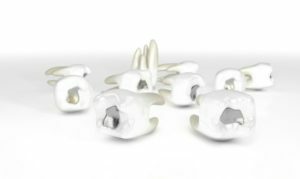 The filling is the final stage in the treatment of many tooth pathologies, be it caries, wedge-shaped defects, restoration after cleavage, or restoration of the enamel after removal of the braces.
The filling is the final stage in the treatment of many tooth pathologies, be it caries, wedge-shaped defects, restoration after cleavage, or restoration of the enamel after removal of the braces.
Modern dentistry has a wide arsenal of various types of dental fillings. In this case, the use of each has its advantages and disadvantages.
What are the types of fillings for teeth and which ones are best used in each case?
Contents
- Base seal
- Plastic fillings
- Amalgam fillings
- Use ceramics
- Light curing composites
- Glass ionomer cement
- Chemically cured composites
- Sealing stages
- Sealing cost
- How much does it seal the tooth?
The cement fillings are based on
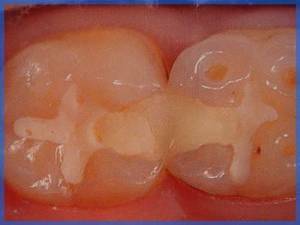
The cement seal on the tooth
As the cement fillings have excellent adhesion, that is, they perfectly adhere to the tooth surface, they are very common in dentistry. These are durable, non-fragile elements, can stand for a long time.
There is one nuance: the density of such seals is higher than the density of tooth enamel and with time wears out that part of the tooth that surrounds the seal. As a result, at the edge of the seal a vulnerable zone is created, secondary caries occur.
The compositions of cement fillings are divided:
- on phosphate cements, which contain up to 90% zinc oxide, magnesium oxide, silica and orthophosphoric acid;
- on silicate-containing mixtures of , containing aluminosilicate and orthophosphoric acid.
Phosphate cements are not used for surface works, they seal channels, put under crowns or under an overlying layer.
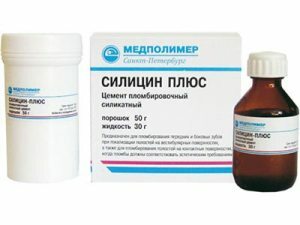 Silicate cement is more similar to the natural tooth color and has a shiny surface.transparency. Since it is very hard material, it is suitable for sealing the front teeth.
Silicate cement is more similar to the natural tooth color and has a shiny surface.transparency. Since it is very hard material, it is suitable for sealing the front teeth.
With deep sealing, silicate cements are not used, as they adversely affect the soft tissues of the pulp.
Of a mixture of the above species are erodont-cement. Also suitable for different types of sealing.
To improve the quality of the fillings, silver powder is added to the phosphate formulations. These compounds are used in the treatment of teeth in children, these are very inexpensive materials.
Plastic seals
Plastics used in dental technology, fast seal, have high hardness, strength, are chemically stable and do not irritate the tissues of the oral cavity. 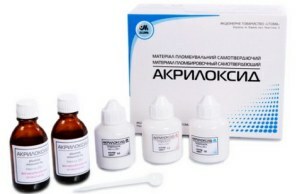
The problem with their use is the reduction in their volume, over time, a person feels that the seal has sagged, slightly decreased in size, which gradually leads to the destruction of the tooth.
Plastic seals also tend to stain, do not last long the original color. These fillings include acryloxide and carbide.
Acrylic-containing plastics are strong, but have a chemical toxicity and eventually lead to inflammation under the seal. Carbodite forms a less porous material, less toxic, but brittle, and over time, aplomb becomes darker than the tooth.
Amalgam fillings
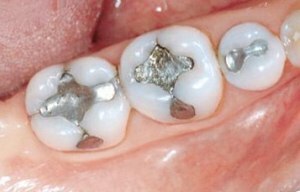
The quality of amalgam fillings, which are an alloy of mercury and metals, is very high.
Amalgams can contain silver, tin, copper, zinc, mercury. These are very plastic, well adhering materials, having great strength and serving several decades.
The negative quality is that the material remains with a metallic sheen, so it is placed only on low-visibility places. Mercury poisoning the body does not receive. The most commonly used silver amalgam.
Use of ceramics
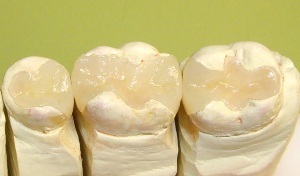
In the photo ceramic inserts on the gypsum model
Ceramic fillings have high hardness and do not lose their sizes with time - shrinkage does not occur.
The seals of ceramics do not change their color, they do not acquire dark shades or spots. This, you can say, is an ideal seal.
The seal is made in the form of a tab on the impression from the treated and disinfected tooth. Due to its configuration, the insert distributes the load evenly over the tooth when chewing, holds tight.
There are different types of ceramics, for example, containing zirconium oxide - transparent and strong;extruded ceramics, cermet.
Light-curing composites
Seals on teeth made of light-curing composites are also called "light" seals. Polymerization reactions of the substances that make up these fillings occur under the influence of ultraviolet irradiation.healed teeth will eventually shrink, but the first time the fillings look perfect.
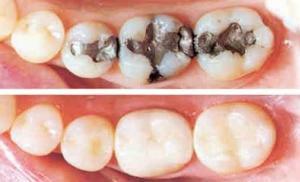
These materials are well polished, microfilae are used on the front teeth, macrophiles - on the more massive rear.
Self-curing material with silicon and zirconium particles is used to restore the surface of chewing teeth. For hard-to-reach areas, fluid-based composites are used.
When setting a seal, each layer is exposed, starting with the adhesive coating. The seal can cost over $ 100 and must stand for at least 5 years.
Composite Fixing and Characterization:
Glass Ionomer Cement
This group of materials contains a significant amount of fluoride, which prevents the emergence of secondary caries, it serves well for the healing of teeth in children.
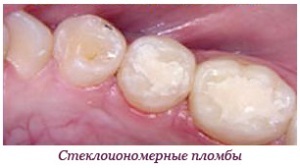 The brittleness of the resulting material is considered to be a negative property. These cements can be both self-curing and light-curing, the dentist provides comfort when working with such material, there is no rush in the installation.
The brittleness of the resulting material is considered to be a negative property. These cements can be both self-curing and light-curing, the dentist provides comfort when working with such material, there is no rush in the installation.
Glass ionomer fillings as on the photo on the right, does not always correspond to the color of the tooth, it is necessary to cover it with composite material.
The cost of such seals, depending on the complexity of work and the use of light-curing composite materials can be different.
Chemically cured composites
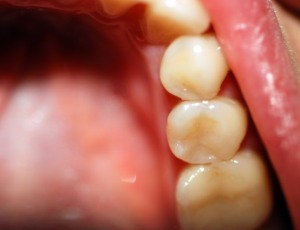
The main component of such compositions is porcelain, which determines the hardness and durability of the installed seals.
Polymerization shrinkage, which is a minus of these seals, is compensated by additional adhesive preparations that improve adhesion to the tooth tissue and do not allow secondary caries.
The main advantage of chemically cured composites is that the hardening takes place evenly throughout the depth of the cavity.
Stages of filling the seal
When treating a diseased tooth, after establishing a primary diagnosis, the doctor removes the softened dentin, cleaning the tooth surface from the affected tissues. 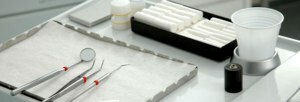 Already at this stage, patients sometimes require anesthesia. With a deep lesion they put a medical pad with calcium to relieve inflammation.
Already at this stage, patients sometimes require anesthesia. With a deep lesion they put a medical pad with calcium to relieve inflammation.
Under the aesthetic surface of the seals, an insulating spacer is laid from high-quality materials with maximum adhesion. The next stage is the setting of the seal, if the material is used light-curing, then each layer of the seal shines.
The cost of sealing
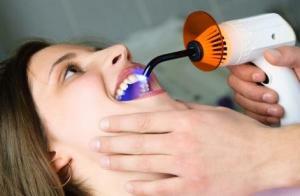 The use of modern technology with expensive medical materials and fillings, the use of expensive equipment and the high level of skill of the dentist represent a significant cost.
The use of modern technology with expensive medical materials and fillings, the use of expensive equipment and the high level of skill of the dentist represent a significant cost.
Comfortable treatment of infected teeth is worth considerable money. The price for treatment, for filling the canals in case of need, for the installation of the seal consists of different parameters.
In each case, treatment is individual, sometimes the tooth can be healed in one visit, and sometimes the doctor and the patient have to meet three times.
All the stages of treatment are thesis:
- primary examination;
- cleaning of the affected cavity;
- introduction of medication;
- if necessary, X-rays of the roots of the tooth for accurate diagnosis;
- cleaning and forming channels;
- removal of nerves;
- canal sealing;
- staging a temporary seal or, in consequence, a permanent seal.
The prices for all these stages are in the price lists of the clinics.
The cost of a seal on a tooth can also be very different. Composite, light fillings can be an order of magnitude more expensive than cement ones.
Sealing of the tooth canal itself, which is several in the tooth, also consists of separate stages - this is the biological treatment of each channel, closing of the existing enlarged hole, covering the surface with a light-curing composite. The formation of prices in each clinic is based on the quality of the drugs used for treatment and filling, the range of which is different.
How much does it take to seal a tooth?
Approximately actual seals prices in Moscow:
-
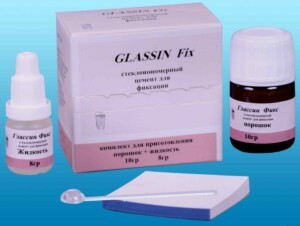 composite fillings without taking into account tooth treatment and gasket setting 2400 rubles ;
composite fillings without taking into account tooth treatment and gasket setting 2400 rubles ; - filling of glass ionomer cement 3000 rubles ;
- ceramic insert without taking into account works 2800 rubles ;
- metals - about 1500 rubles .
Children's orthodontics and filling of teeth for children in some cases, qualitatively different from adults, the installation of seals to children usually performed faster than adults and the price does not exceed 2000 rubles.
The removal of the old seal will cost about 400 rubles, the imposition of a medical or insulating pads will cost from 700 to 2000 rubles.
Restoration of the tooth with a deep lesion with the installation of a light seal includes many parameters, and the seal itself will cost from 4000 rubles. Anesthesia when working with a tooth costs 300-400 rubles, and the same is worth an x-ray of the jaw.
